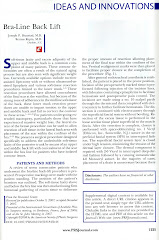So, what defines a full tummy tuck?
A full tummy tuck or abdominoplasty is best defines by the length of the lower incision as well as the release of the belly button from the abdominal skin and soft-tissue. Of course, most full abdominoplasty procedures also invlove muscle tightening if there is is abdominal wall laxity, and liposuction if there is excess adiposity (fat) in the abdominal soft-tissue and surrounding areas. However, it is the length of the incision and whether or not the belly button is released that trully defines a full abdominoplasty. The length of the incision usually spans the hip bones or ASIS (anterior superior iliac spines). It can be a little shorter or a little longer but not by much. A significantly shorter incision together with a belly button that is not detached from the surrounding skin and soft-tissue better defined as a mini-tummy tuck. Conversely, an incision that is much longer, that goes beyond the hip bones and onto the sides of the hips or flanks is better defined as an extended abdominoplasty (to be discussed in later post). The idea behind this is that an incision that extends onto the hips and flanks requires the patient to be rolled slightly during surgery in order to have access to these areas. Most importantly, however, an incision that goes beyond the hips bone and onto the side of the hips and flanks implies that the patient had significant exess soft-tissue laxity and the question then becomes whether a circumferential abdominoplasty (aks body lift, circumferential belt lipectomy, around the world abdominoplasty). I will discuss the circumferential abdomioplasty in great detail in a later post.
Who is not a good candidate for a full tummy tuck?
The very first answer to this question is anyone that is not healthy enough to undergo a full tummy tuck or any abdominal contouring procedure safely.
There are two groups of patients that are not ideal candidates for a full abdominoplasty. Those that do not have enough excess soft-tissue laxity and those that have two much soft-tissue laxity to benefit from the full tummy tuck. Of course there are some patients that would be better served by endoscopic tummy tuck or mini tummy tuck, as discussed in the previous posts. The other group of patients are those that have significant excess soft-tissue laxity. These patients would not get enough correction by limiting the incision up to the hip bones. If this is done one of two things usually results. The first is that the patient is left with laxity and will not be happy. The scond is that there can be folds of skin and soft-tissue at each end of the incision termed "dog-ears" (to be discussed in greater detail in later posts on complications). The reason for this is similar to pleating when clothing is tailored.
So, is the full tummy tuck a good procedure?
Absolutely. For the proper candidate the full tummy tuck is a great procedure. Procedure s are not inherently good or bad. They are good when performed properly for the appropriate patients and bad when performed poorly for patients that are not good candidates.
Next up. Use of liposuction in tummy tucks.
All the best,







